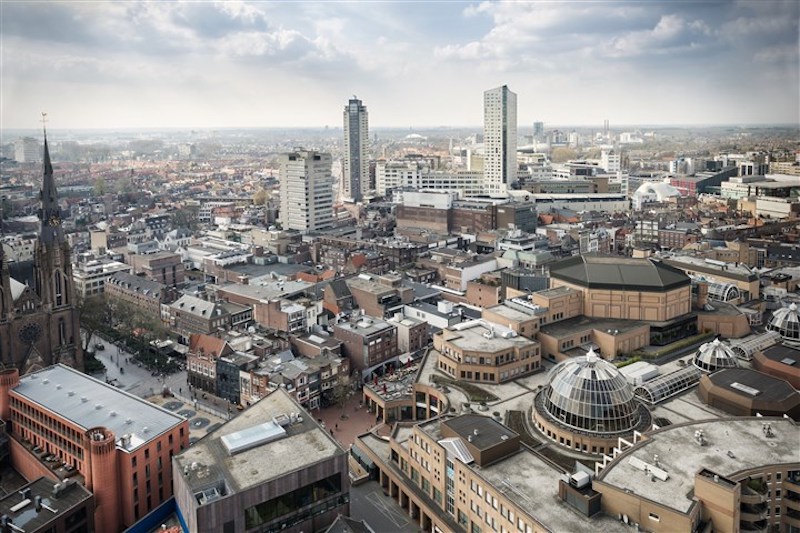(Editor’s note: We started the Eindhoven Business Briefing in 2017, because we had more news in our headquarters city – which has a huge expat population – than we could possibly post. The future really is being invented here. Send your news to: [email protected])
You thought you lived in Eindhoven. Wrong. You live in Brabantine City Row as of last month. That’s when LinkedIn notified us about our involuntary change of address.
From that email:
Your current location is displayed as Eindhoven Area, Netherlands and will be automatically updated to Brabantine City Row on October 12, 2020.
We’ve been here for years, but until that email, we’d never heard of Brabantine City Row, or the Dutch version, Brabantse Stedenrij. But both are what we Americans would call a “metropolitan statistical area” of cities and towns with close ties to each other and all attached economically to a larger city.
Which is why we look at New York City not as five boroughs with a population of 8 million, but as an MSA of 19 million, including the five boroughs, Long Island and parts of New Jersey. In turn, New York is part of an Eastern Seaboard metroplex running from Washington D.C. on the south to Boston on the north, with a total population of more than 30 million people. Almost as big as Tokyo.
With Eindhoven, BCR is made up of a bunch of actual cities, as well as some small municipalities including:
• Eindhoven, population about 217,000
• Tilburg, a surprising 189,000, almost as large as the Big E
• Breda, about 145,000
• ‘s-Hertogenbosch, aka Den Bosch, at about 107,000
• Helmond, 88,000
Throw in the rest, including places we never heard of – Etten-Leur? – and you have a total of about 2 million souls.
Looking at population centers as metroplexes is a thing in Germany, where Cologne, Düsseldorf, Duisberg, Essen, Bonn and other cities are grouped together as Rhine-Rhur, with a total population of more than 10 million. But that kind of thinking is heretical here in our area where each city section is considered its own special place, with its own gemeente, or administrative city hall.
It’s not so radical above the rivers where the Netherlands’ four largest cities – Amsterdam, Den Haag, Utrecht and Rotterdam – are the Randstad. The Randstad rakes in the majority of government subsidies because – let’s face it – having Europe’s busiest port, one of Europe’s most important business centers, administrative capital and the major university city makes the region the Netherlands’ economic engine.
The advantages of rethinking urban connections are many, including getting more community leaders focused on regional issues instead of thinking parochially. It also helps attract talent because international talent doesn’t think in terms of villages. In the U.S., it’s not uncommon for people living in Atlanta or Dallas to live 40 kilometers or more from the city yet still consider themselves part of the metropolis.
Amber goes mass market
Innovation Origins has an interesting post about Amber Mobility’s shift to a drive-and-drop mobility company.
Amber started back in 2017 with the goal of developing self-driving cars, and they did. But the more practical business turned out to be providing companies with convenient car-sharing alternatives to fleet cars and taxis, with 88 hubs around the Netherlands including in Amsterdam and Eindhoven. Now, they’re going mass-market, opening up to the general public, promising to get you a car within an hour, then allowing you to drop it off wherever you end up.
Sort of the Lime of electric cars.
Amber currently has 145 cars – specifically electric BMW i3s – ready for customers. For more information check out the Amber website. You can get an Amber car for about 35 euro cents per kilometer, but there are better rates and packages for people who need to drive a lot.
Sendcloud moves to a huge space on redeveloping Stadhuisplein
We heard about e-commerce shipping startup Sendcloud, one of Europe’s fastest growing tech companies, back in 2017 when we put them on our list of local startups as we began to lure investors in the United States to Eindhoven. Then Financial Times editors started putting Sendcloud on their list of the 1,000 fastest growing companies.
Now they’re moving into 5,000 square meters (about 60,000 square feet) on Stadhuisplein in the center of the city, according to a news release from Certitudo Capital. The company will move to Stadhuisplein from the current Tongelre HQ in November, according to the ED post. Sendcloud also has operations in Munich.
And now for the rest of the story.
The Sendcloud move is part of a larger plan to redevelop the empty space next to the city gemeente, which is currently a concrete skateboard park. Certitudo Capital, a ‘s-Hertogenbosch-based real estate developer/private equity firm, wants to build really, really tall residential high-rises, up to 175 meters, or almost 600 feet, tall. That would easily be the tallest building in Eindhoven, and even taller than De Rotterdam, Rem Koolhaas’ famous 44-floor building, which is only 149 feet tall.
This is from the Certitudo Capital website:
The entire Stadhuisplein in Eindhoven will be transformed in the coming years from a monofunctional environment with a lot of vacancy to a lively multifunctional area with living, working and shopping. Certitudo Capital is currently in talks with the Municipality of Eindhoven about possible redevelopments of the property. Both making the existing office building more sustainable and revitalizing for office use as well as a housing development are possible. Winy Maas, architect of the Markthal in Rotterdam, among others, was appointed by the municipality of Eindhoven as supervisor of the city center and advises the municipality on all major developments, including this one.
For the uninitiated, Winy (whinney like a horse, not “winy” like a baby) Maas is the global rock star founder of MVRDV, the most famous architecture firm in the Netherlands, which designed the amazing Markthal in Rotterdam.
Having covered commercial real estate in the United States for years, we know one thing – for great things to happen, there has to be a main client driving a project and lots of capital. We’ll see ….
You can still join a deep-tech team at FasTrackathon
There’s still time to join FasTrackathon on 16 September.
HighTechXL has added tech from TNO to create at least five potential startups. The venture building program starts with FasTrackathon, an online event bringing together all the potential founders and team members. (More than 70 people have signed up, and you can register here.)
The technology in this cohort includes:
• TNO, the Netherlands’ independent research center, has developed a novel printed image sensor technology for fingerprint detection applications that can read larger areas as well. This technology has multiple potential uses from building security to customs checks, payments and advanced security for cars. A sensor prototype is available as well as a setup to produce prototypes.
• A sub-millimeter spectral imaging camera from the European Space Agency has almost limitless potential applications. Novel sub-millimeter wavelength imaging cameras work in the terahertz frequencies, essentially looking through clothing and fabric. So, these cameras could reveal hidden weapons. Terahertz radiation has also been identified as a potentially powerful diagnostic tool for the early detection of skin cancers.
You can see all the details for all five technologies here.
Group turns to crowdfunding to save HEMA
If you, like us, like the bargains at HEMA and have been following the saga of this uniquely Dutch discounter, you can help save the company.
As we reported back in June, too much debt and the pandemic have creditors scrambling trying to save HEMA. Now, a citizens group is trying to crowdfund enough money to take a minority stake in the company in order to have a say in its future.
The citizens’ initiative believes that HEMA has become a plaything for large investment companies and wants to influence the course of affairs in the chain by acquiring a minority stake.
PvdA Senator Mei Li Vos is leading the effort to save what she terms “the store for everyone.”
Studyportals has new deal with Times Higher Education
Eindhoven-based Studyportals, which helps students wishing to study abroad choose a university, and Times Higher Education, the London-based media company that rates those unis across the globe, have a new partnership.
Basically, Studyportals will direct visitors from the THE website to the Studyportals platform for more information about specific courses run by the universities THE ranks.
Studyportals list more than 200,000 on-campus and online courses from more than 3,750 universities in 116 countries. They reported 36 million unique users in 2019.
You can read the full news release from Studyportals here.
Just how each company is monetizing this isn’t clear in the release, but we’re guessing Studyportals pays a fee for tapping into the 28 million people who come to the THE website each her.
QUICK HITS
• The overall Dutch economy has proved its resilience, shrinking only 8.5 percent in the Q1 due to the pandemic. Compare that to the United Kingdom at 20 percent, Germany at 10 percent, Italy at 12 percent, France at 14 percent and Spain at 19 percent.
• Technical University of Eindhoven is dedicating 10 million euros to create a sustainable energy institute. The focus area will be production and use of sustainable energy carriers such as hydrogen, ammonia, metal powder and renewable carbon fuels including methanol.
• Researchers at TU/e also used a tiny tentacled marine creature as inspiration for a centimeter-scale robot that is powered by magnets and light.














